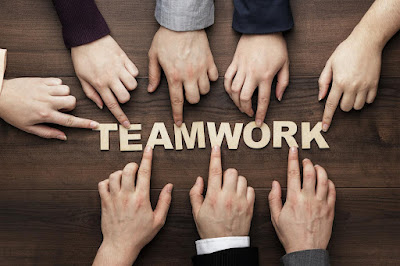For an
organization to run smoothly and meet its goals, it is important to foster a
work environment that supports collaboration amongst colleagues. Unfortunately
for most organizations, team cooperation does not occur naturally. You must
make an effort and take steps to help build and sustain a cooperative work
environment.
Team
cooperation in the workplace can mean many things. It involves the level at
which employees participate in decision-making, how management and employees
work together to resolve problems, and how all levels of the organization work
together to achieve common goals.
If you know
collaboration is important but your team still hasn’t quite mastered it, don’t
worry — here are some ways to improve those skills.
1. Teamwork
must become part of your workplace culture
For coworkers
to successfully collaborate, the leadership within the organization must work
to make collaboration one of the key values of the enterprise. Employees must
see that the leadership within the firm works together as a team to accomplish
goals. Also, the company’s leadership must award teams publicly when they are
successful at working together to achieve their objectives.
To truly
improve cooperation skills, leaders must provide an environment where employees
are not afraid to share their ideas. Leaders must create a culture with
positive team dynamics where the exchange of ideas is encouraged and rewarded.
Teamwork and collaboration must be a central theme of the corporate culture to
improve team cooperation.
2. Provide
teams with the resources they need to work collaboratively
To make
improvements with communication, the organization must provide the necessary
resources to the teams. This includes comfortable workspaces where the teams
can work together. If the teams are spread out amongst different locations,
then the organization must provide the resources that allow the teams to work
together remotely, such as video conferencing.
3. Be an
example
Being the
leader of a team requires setting an example of collaboration because team
members often react to the environment that managers create. You can use your
role as manager or team leader to exhibit being open to new suggestions. You
may also support team members who are debuting a new skill or contributing a
new idea, which helps expand the team's skill set.
4. Clarifying
roles and setting expectations
Organizations
will find when all employees are on the same page, team collaboration will
quickly become a seamless and natural process. Making sure each employee
understands – not only his or her role, but also the roles of the people around
them will help everyone understand the big picture and how they fit into the
larger puzzle.
It is also
imperative that the leadership sets clear expectations for teams so that as
employees work together, everyone is clear on which goal or objective needs to
be reached.
5. Encourage openness and feedback
In order for
your team to collaborate together successfully, they need to feel comfortable
in sharing their thoughts, opinions, ideas, concerns, and feedback.
It’s important
to foster an environment that encourages openness and feedback. Encourage
constructive criticism, share successes and failures with your team, and let
them know there’s no such thing as a stupid question! When people feel safe
enough to speak openly, teams can work together more successfully.
6. Resolve team
conflict quickly
No team will
ever be perfect, and it is crucial for organizations to recognize this and have
a system in place to handle any conflicts that arise. The system should allow
any employee to share their concerns without repercussions. Also, employees
should be allowed to have input on any solution to implemented by the
organization.
Employees who
know there is a system in place and are comfortable knowing the dispute will be
handled fairly will be able to work with other team members in a healthy and
collaborative manner.
7. Celebrate and reward successful teamwork
How you measure
your team’s success will signal what kind of company you are. If you reward
effective teamwork and successful collaboration, you communicate the values
underpinning your business.
When you design your employee appraisal metrics, focus on team collaboration and individual successes. Make it clear that your employees’ team efforts will be noted, and collaborative achievements rewarded.








